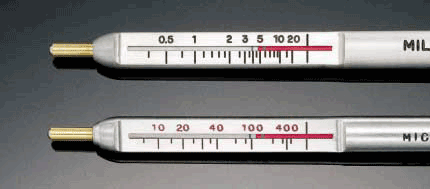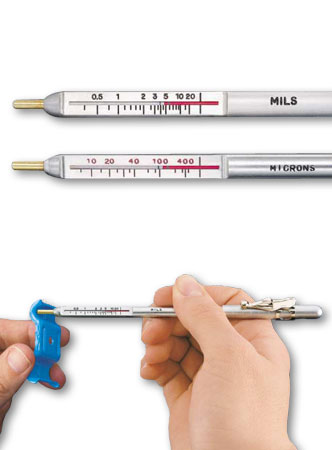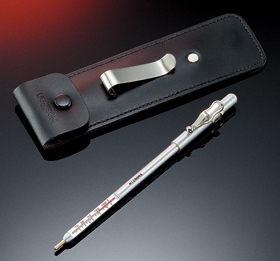The PosiPen is a magnetic pull-off coating thickness gauge. It is designed to measure non-magnetic coatings such as paint, enamel, plating, & hot-dip galvanizing on steel. It is ideal for measuring small parts, hard-to-reach surfaces and high temperature materials up to 230° C (450° F). The PosiPen is the only gauge we offer that can measuring coating thickness on wire. Note the wire must be steel.
PosiPen can be placed with pin-point accuracy on any location of the part to be measured which other Gauges are not able to reach.
PosiPen measures:
- on hot surfaces
- on small surfaces
- in different positions
PosiPen has a very small unique magnet and therefore can measure on extremely small parts, on peaks and valleys.

The PosiPen has two scales, mils and microns
- Includes NIST Traceable Calibration Certificate
- Conforms to National and International Standards including ASTM D7091/B499, ISO 2808 and others
- Two (2) Year Warranty
- Made in the USA
| Range | 0.25 to 20 mils (5 to 500 microns) |
| Tolerance | ±10% and 0.1 mil (2.5 microns) |
| Temperature Limits | -150 to 450 °F (-100 to 230 °C) |
Is the PosiPen calibrated at the factory?
The PosiPen arrives fully calibrated and ready to measure. A Long-Form Certificate of Calibration traceable to NIST or PTB is included, which documents actual readings taken by your instrument at our calibration laboratory on standards traceable to a national metrology institute. Beware of ‘Certificates’ or ‘Certificates of Conformance’ offered by competitors. These typically do not include actual instrument readings, and are often insufficient to meet common quality requirements.
Why should I purchase the PosiPen instead of the PosiTest?
The PosiPen is ideal for measuring non-magnetic coating thickness with pinpoint accuracy on ferrous metal parts with temperatures ranging from -100C to +230C (-150F to +450F). The PosiPen uses a very small magnet can be precisely placed on extremely small parts and on coated surfaces which cannot be accessed by other, larger gages.
Is the PosiPen affected by the roughness of the steel substrate below the coating?
All coating thickness gages are influenced to some degree by substrate roughness. It is generally accepted that coating thickness should be measured from the highest ‘peaks’ in the rough surface thus ensuring they are covered by the protective coating. However, coating thickness gages will instead measure the coating thickness from the effective magnetic surface, which is located somewhere between the highest peaks and deepest valleys of the profile.
To compensate for the influence of substrate conditions (including roughness), measure the uncoated substrate/part at a number of spots to obtain a representative average value. This average value is called the “base metal reading” or “BMR”. Subtract the BMR from subsequent coating thickness measurements to obtain the thickness of the coating over the ‘peaks’ of the rough surface.
Can the PosiPen measure coatings on small diameter wire?
Yes. The PosiPen will accurately measure the thickness of non-magnetic coatings on a ferrous 18 AWG and larger wire.
Can the PosiPen measure nickel on steel?
Yes, but it depends upon the particular type of nickel coating that has been applied to the steel.
When nickel plating is deposited by a process of electrolysis (employing an electric current in the nickel bath), the resultant coating – commonly called “e-nickel” – is always conductive and magnetic to some degree and cannot be accurately measured by our gages when applied to ferrous or non-ferrous metals.
Electroless nickel coatings are deposited by an autocatalytic process which does not involve the addition of an electric current. If the nickel bath in this process contains a minimum concentration of ~8% phosphorus, the resulting nickel plating is effectively non-magnetic and its thickness can be accurately measured on ferrous steel with a magnetic principle coating thickness gage such as the PosiPen.
Does the PosiPen measure on non-ferrous metals, like aluminum?
No. As a magnetic principle instrument, the PosiPen will measure the thickness of non-magnetic coatings applied to ferrous metals. Our popular PosiTest DFT Combo and powerful PosiTector 6000 N gage models are ideal for measuring the thickness of paint, anodize and other non-conductive coatings applied to non-ferrous metals.
Can the PosiPen be adjusted?
No. The PosiPen uses a precision, permanently- calibrated spring which will never require adjustment.
The PosiPen arrives fully calibrated and ready to measure. A Long-Form Certificate of Calibration traceable to NIST or PTB is included, which documents actual readings taken by your instrument at our calibration laboratory on standards traceable to a national metrology institute. Beware of ‘Certificates’ or ‘Certificates of Conformance’ offered by competitors. These typically do not include actual instrument readings, and are often insufficient to meet common quality requirements.
Why should I purchase the PosiPen instead of the PosiTest?
The PosiPen is ideal for measuring non-magnetic coating thickness with pinpoint accuracy on ferrous metal parts with temperatures ranging from -100C to +230C (-150F to +450F). The PosiPen uses a very small magnet can be precisely placed on extremely small parts and on coated surfaces which cannot be accessed by other, larger gages.
Is the PosiPen affected by the roughness of the steel substrate below the coating?
All coating thickness gages are influenced to some degree by substrate roughness. It is generally accepted that coating thickness should be measured from the highest ‘peaks’ in the rough surface thus ensuring they are covered by the protective coating. However, coating thickness gages will instead measure the coating thickness from the effective magnetic surface, which is located somewhere between the highest peaks and deepest valleys of the profile.
To compensate for the influence of substrate conditions (including roughness), measure the uncoated substrate/part at a number of spots to obtain a representative average value. This average value is called the “base metal reading” or “BMR”. Subtract the BMR from subsequent coating thickness measurements to obtain the thickness of the coating over the ‘peaks’ of the rough surface.
Can the PosiPen measure coatings on small diameter wire?
Yes. The PosiPen will accurately measure the thickness of non-magnetic coatings on a ferrous 18 AWG and larger wire.
Can the PosiPen measure nickel on steel?
Yes, but it depends upon the particular type of nickel coating that has been applied to the steel.
When nickel plating is deposited by a process of electrolysis (employing an electric current in the nickel bath), the resultant coating – commonly called “e-nickel” – is always conductive and magnetic to some degree and cannot be accurately measured by our gages when applied to ferrous or non-ferrous metals.
Electroless nickel coatings are deposited by an autocatalytic process which does not involve the addition of an electric current. If the nickel bath in this process contains a minimum concentration of ~8% phosphorus, the resulting nickel plating is effectively non-magnetic and its thickness can be accurately measured on ferrous steel with a magnetic principle coating thickness gage such as the PosiPen.
Does the PosiPen measure on non-ferrous metals, like aluminum?
No. As a magnetic principle instrument, the PosiPen will measure the thickness of non-magnetic coatings applied to ferrous metals. Our popular PosiTest DFT Combo and powerful PosiTector 6000 N gage models are ideal for measuring the thickness of paint, anodize and other non-conductive coatings applied to non-ferrous metals.
Can the PosiPen be adjusted?
No. The PosiPen uses a precision, permanently- calibrated spring which will never require adjustment.





